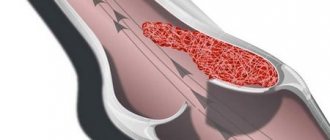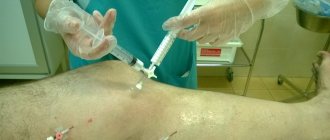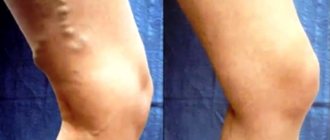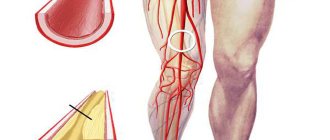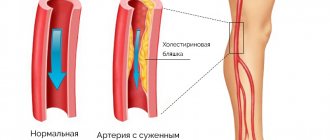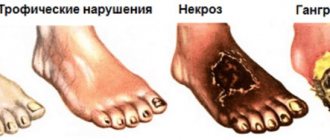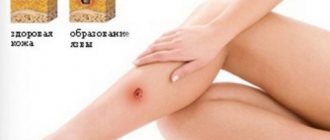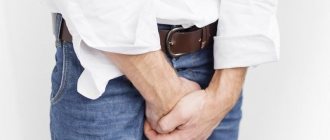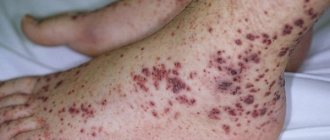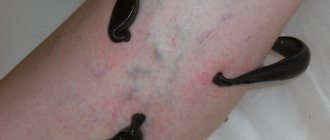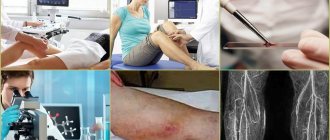Causes of internal varicose veins
A circulatory disorder characterized by dilation of the deep vessels of the lower extremities is called internal varicose veins. The disease is more common in women, and the risk of developing the disease increases with age.
The following causes provoke the disease:
- The period of bearing a child. Due to pressure on the organs and vessels of the pelvis, the functioning of the circulatory system deteriorates.
- Wearing tight clothing and high-heeled shoes.
- Hereditary factor.
- Sedentary lifestyle or standing work.
- Failure in metabolic processes.
- Hard physical labor.
- Diabetes.
- Poor blood clotting.
- Exposure to certain medications.
- Abuse of alcohol, drugs, smoking.
- Stress.
Diagnosis and treatment
Modern examination techniques will help a specialist make a diagnosis of hidden varicose veins of the internal veins:
- Angiography is an x-ray of blood vessels with the introduction of a contrast agent into the bloodstream, which allows one to trace the flow of blood through the veins.
- Lymphography - helps to detect a violation of the outflow of lymph, causing swelling of the legs.
- Computed tomography, which provides a two-dimensional image of blood vessels and allows visual observation of their defects.
- Ultrasound examination (ultrasound) - determines the condition of the walls of the veins and the degree of functionality of the valves in the vessels.
Blood tests will also need to be done. A general analysis (CBC) will show the level of hemoglobin, platelets and red blood cells, allowing you to determine the presence of an inflammatory process. Hemostasis will help determine the risk of blood clots.
Diagnosis of internal varicose veins
After diagnostic procedures, based on the examination results, the doctor develops a therapeutic strategy, deciding how and how to treat internal varicose veins. This includes a set of therapeutic measures, including:
- Wearing compression garments - they are purchased at pharmacies, based on the recommendations of a phlebologist. These could be knee socks, stockings or tights - it all depends on the location of the affected area. The doctor also determines the required degree of compression on the veins, which varies from 20 to 100% (the figure is indicated upon sale);
- Sclerotherapy is a minimally invasive procedure that involves the introduction of a special substance (sclerosant) that clogs diseased internal vessels. As a result, they are excluded from the bloodstream, and their function is transferred to the so-called collaterals - nearby small blood vessels, which subsequently increase to the required size, becoming full-fledged veins;
- Drug treatment of varicose veins of internal venous vessels using anticoagulant drugs that reduce the degree of blood density, as well as venotonics that strengthen the walls of internal vessels.
Important!
With timely measures taken, these procedures can stop the development of varicose veins of the internal veins and relieve negative symptoms. To maintain a stable therapeutic effect, they must be regular, and observation by a phlebologist must be systematic, regardless of the patient’s subjective feelings.
Symptoms
Internal varicose veins in the legs are dangerous because they do not appear immediately and have an asymptomatic period.
The disease can be suspected based on some signs:
- Aching pain in the evenings, heaviness in the legs after a hard day. Mild pain at the beginning of the disease is relieved by taking analgesics, which delays the trip to the doctor.
- Edema. Depending on the stage of the pathological process, swelling can be either barely noticeable or large; a problem arises while wearing shoes.
- Spider veins that spread over the entire surface of the leg.
- Cramps of the calf muscles during sleep and during exercise.
- Changes in the color of the skin over the site of the disease.
- The skin on the legs may become dry, have poor regenerative properties, and symptoms of dermatitis or eczema appear.
There are several methods of surgical treatment:
- Radiofrequency vascular obliteration. The structure of the veins is restored from the inside.
- Endovenous occlusion by impulses. The vessels are affected by steam flows, which allows them to penetrate into any part of the veins.
- Laser coagulation of veins. A special laser is used for treatment.
- Venaseal technique. The valves of the vessels are glued together using biological glue.
- Varadi method. The vessel is removed, which shows 100% effectiveness of treatment.
In particular, in the health care institution 5GKB, radial endovenous laser obliteration is used for treatment. The procedure lasts about 60 minutes and reduces the risk of nerve damage. You are supposed to wear special underwear (compression) only for a week; you can return to your normal lifestyle almost immediately. All stages of the procedure (from diagnosis to intraoperative navigation) are carried out using ultrasound angioscanning, which shows high efficiency.
5 City Clinical Hospitals employ real professionals who use only proven treatment methods. Patients highly appreciate the work of the clinic’s doctors and gain confidence in the correct stages of treatment. 5 GKB is equipped with high-quality equipment. Specialists constantly improve their skills.
Sclerotherapy
For sclerotherapy, special medications are used to “glue” the veins together from the inside. The procedure is carried out invasively, the solution is administered intravenously. The injected substance is gradually absorbed and excreted. Sclerotherapy is prescribed if a specific vascular condition is established.
Treatment of varicose veins at home
Only a phlebologist can prescribe the correct treatment, but in addition to drug therapy, traditional methods are often used.
Many patients prepare ointments and infusions:
- A ripe tomato is cut into slices and placed along the veins for several hours.
- Iodine and ammonia are mixed and the resulting liquid is rubbed on the feet.
- Mix butter and garlic. The mixture is applied to the legs and covered with an elastic bandage.
- Horse chestnut is infused with vodka (2 weeks). The tincture is used both internally (a few drops) and externally.
- Potatoes (raw) are grated, placed on the legs and covered with a bandage. It must be removed after a few hours.
- Hot baths with a pack of baking soda (for 15-20 minutes, no more than 2 times a week).
Honey and cabbage leaves help relieve discomfort. The resulting product is covered with polyethylene and bandaged. It washes off after a few hours. To reduce pain, rub your feet with apple cider vinegar. Contrast baths - hydrotherapy - show excellent results. Pieces of ice are used to reduce swelling.
Yoga and special exercises help, which require:
- Sit on the floor and stretch your legs. The leg bends at the knee, the other one needs to be raised. Repeat 9 times.
- Stand up, legs slightly apart. Squats are performed to knee level, arms are extended forward. Repeat 9 times.
- Stand near a support, spread your legs wide. Squats are performed, the heels are lifted off the floor. Repeat 15 times.
- Stand up, rise on your toes several times and lower onto your heels. Repeat 15 times.
It is worth noting the need for proper nutrition. Eat foods that contain vitamin C as often as possible. You need to drink about 2 liters of water daily. Sugar, confectionery, strong tea and coffee, spicy and hot seasonings are excluded from the diet. The most useful are vegetables (cabbage, tomatoes, sweet peppers), fruits (apricots, apples, citrus fruits, peaches, cherries, cherries).
Many of the folk remedies listed above increase vascular tone, optimize oxygen metabolism, restore the functioning of vein valves, eliminate swelling, and reduce inflammation. Such products consist of natural substances and are easy to prepare.
Herbal treatments for varicose veins are not suitable for every patient. It is not always possible to predict the effect for pregnant women with hypertension or hypotension.
You cannot rely solely on folk remedies! Full control of the attending physician is necessary, who will prescribe truly effective treatment.
Stages of the disease
There are several stages of development of internal varicose veins of the lower extremities.
- Initial. The disease practically does not manifest itself and causes heaviness in the legs after a long day of work, long walks or intense sports.
- The second stage of varicose veins is characterized by the appearance of slight swelling in the area of the feet and ankle joint. Sometimes at this stage, fatigue and aching pain in the evenings are accompanied by cramps.
- The third stage of development of varicose veins is accompanied by an inflammatory process of the walls of the veins, a deterioration in the general condition, a local increase in temperature, fever, and intoxication. The skin is hot and changes its color to a pale, reddish tint.
- In the fourth stage of varicose veins, the patient develops necrosis or gangrene due to infection of the inflamed vein.
Symptoms at different stages of political science
Signs of the disease appear gradually, so each of the four stages has its own symptoms.
1st stage
At the first stage, it is not possible to determine the disease, since clinical symptoms have not yet appeared and no changes have been observed externally. Only pathological deformations indicate the onset of the disease. Thus, the outflow is disrupted and small stagnant processes are started, while the valve system of the deep veins still manages to cope with the load.
2nd stage
It is diagnosed by swelling of the lower extremities. In this case, the patient feels heaviness in the legs, and after walking there is a need for rest. By the end of the day, even with minor uncomfortable movements, a painful cramp begins. At the same time, a feeling of coldness is felt in the lower extremities.
You should not take painkillers to relieve pain and discomfort, because this will only relieve the symptom for a short time while the disease develops.
Only the listed signs indicate the development of the disease, and they gradually intensify. When palpating the affected areas, it is impossible to provoke painful sensations, and no compactions in the thickness of the skin are also observed. If such symptoms are present, as a rule, this indicates inflammation or thrombosis of the deep vein.
3rd stage
If treatment is ignored in the early stages, the third stage occurs, which is characterized by the following symptoms:
- the vessels cannot cope with the job of pumping blood;
- the functioning of the vein valves is disrupted and blood circulation slows down;
- blue spots appear on the skin, which are accompanied by peeling, or erosive areas that do not heal for a long time;
- convulsions of varying strength and duration appear, which are extremely intensified at night, which occurs due to edema and deficiency of nutrients necessary for the smooth functioning of synapses;
- there is pronounced swelling and increased pain;
- the temperature in the affected areas of the skin rises or falls.
If the pathological process occurs in only one leg, its size will be strikingly different from the size of a healthy leg. It will resemble a barrel, the skin will be taut and shiny. This will make it much more difficult to find the right shoe size.
4th stage
This is the extreme stage of the disease, which is accompanied by the appearance of trophic ulcers, gangrenous processes, acute thrombosis, thrombophlebitis, chronic venous insufficiency and bleeding from a ruptured node.
Diagnostics
Detection of the disease consists of several methods:
- External examination of the leg, palpation, collection of anamnesis, including hereditary history.
- Functional tests:
- Schwartz test. Determination of valvular insufficiency of the segment under study by tapping on a varicose node or vein trunk.
- Perthes test. The patient is asked to walk a little, after first clamping the superficial vessels with a tourniquet. With varicose veins, blueness of the skin and painful sensations appear, indicating violations of the deep veins.
- Plantar test - when pressing on the heel, the patient feels pain.
- Ultrasound examination of the limbs.
- Sonographic examination - assessment of the direction and speed of blood flow.
- Duplex scanning. The method combines ultrasound and Doppler, with which you can detect changes in the veins in the early stages and prevent the development of varicose veins.
- Rheovasography is a study of blood supply to organs.
- Phlebography is a method showing the throughput of venous vessels.
General description of the disease
Varicose veins are a disease that causes the venous wall to become thinner and the lumen of the veins to increase.
When the functioning of the veins is disrupted, the blood begins to circulate chaotically, enters the superficial vessels and turns into characteristic “spiders” - winding veins that protrude to the surface.
Today, varicose veins are defined as a real scourge: studies show that they are observed in 30-40% of women and 10-20% of men over 18 years of age. Varicose veins are often diagnosed in middle-aged and elderly people.
Treatment methods
After diagnosing the symptoms of varicose veins of the internal veins in the legs, the doctor determines the principle of treatment.
Drug therapy
Medicines cannot completely cure the disease, but they can alleviate the patient’s condition.
Modern medicine uses a combination of several methods:
- external use of creams to eliminate spider veins and relieve heaviness in the limbs;
- medications that thin the blood and prevent blood clots (antiplatelet agents);
- phlebotonics - normalize blood flow in the veins and remove congestion and swelling;
- medications that eliminate vascular spasms and reduce pain in the legs;
- angioprotectors – reduce venous permeability;
- NSAIDs to eliminate inflammation.
Compression therapy
Treatment with compression garments is possible only in the initial stage of the disease or is more suitable for preventing the development of varicose veins.
Special clothing supports the veins, normalizes blood circulation, preventing stagnation.
Before purchasing the necessary compression garments, you should consult with a specialist, as there are several differences:
- Clothes can be of different types: intended for the prevention, treatment of varicose veins or wearing after surgery.
- Underwear has several classes depending on compression.
Contraindications to compression therapy:
- open wounds and inflammatory processes on the lower extremities;
- diabetes;
- aortoarteritis;
- atherosclerosis;
- obliterating thrombosis.
Foam vein sclerotherapy
A modern method based on the introduction of a drug into the affected vessel in the form of foam, which causes blood clotting inside the vein. Over time, the area of pathology resolves.
For the procedure, one sclerosant is usually used - sodium tetradecyl sulfate. Treatment is carried out on large veins under ultrasound control. After the injection, the patient is tightly bandaged or asked to wear compression garments for a favorable course of therapy.
Laser coagulation
Laser treatment has many positive reviews and advantages over other methods:
- low morbidity;
- use of local anesthesia;
- no complications;
- quick rehabilitation period.
The therapy is characterized by inserting a special light guide into the vessel, which seals the vein and excludes it from the general blood flow. The operation is performed under Doppler ultrasound control; after the procedure, the patient must wear compression stockings for some time.
Surgery
In advanced cases, surgical removal of the affected vein is used - phlebectomy. The operation is performed under general anesthesia. The postoperative period takes place in a hospital setting. The patient is prescribed exercise therapy, massage, wearing compression stockings and taking medications.
Treatment with folk remedies
Alternative medicine uses the properties of medicinal plants as ointments or lotions.
Wormwood is ground and mixed with kefir. Use the resulting mixture as a compress. Keep the bandage on the affected area for up to half an hour.
- 2 tbsp. Bring the willow bark to a boil and let it brew in a warm place for at least an hour. It is advisable to steam your feet in a bath with the resulting decoction at the end of a working day.
- Royal jelly ointment is prepared with the addition of propolis and olive oil. Heat the mixture over the fire, but do not bring to a boil, and add 50 g. glycerin. Apply to affected areas after cooling to relieve pain.
- 4 tbsp. Mix spoons of nutmeg with a spoon of apple cider vinegar and dilute with glycerin. Use the mixture a few centimeters above the affected area. Then rinse with water and rub with cream.
- Horse chestnut tincture. 50 gr. dried flowers are poured with vodka and allowed to brew for two weeks in a dark place. Take 30 drops 3 times a day before meals.
- Nettle infusion is used as a lotion. 5 tbsp. The plants are boiled in a water bath and allowed to stand for an hour. Soak gauze in the decoction and apply to the affected area.
Treatment of varicose veins
If you consult a phlebologist immediately, the pathology will be completely eliminated. In other cases, the specialist uses conservative or surgical treatment, sclerotherapy.
Conservative treatment of varicose veins
Conservative treatment includes sports, physical therapy, wearing special underwear (compression) and elastic bandages, and treatment with phlebotonics. But the conservative method does not completely restore dilated veins. It is used as a prophylactic when the patient is preparing for surgery or when it is impossible to perform it.
Surgery
The operation is performed when the veins are deeply affected and the following complications are diagnosed:
- Thrombophlevititis.
- Strong visual expansion of veins.
- Increased swelling and fatigue.
- Other pathological disorders.
Possible complications
In advanced cases or when prescribed treatment is not followed, varicose veins are complicated by pathologies.
Trophic ulcers
Characterized by formation in the ankle joint. The process begins with small, wet wounds that do not heal for a long time and open at the slightest injury. During the inflammatory process, ulcers bring severe pain, fester and have an unpleasant odor.
Thrombosis
A serious complication that, without treatment, leads to death.
When the disease occurs, the walls of the veins are affected and a blood clot begins to form, which, when broken off, can enter the pulmonary artery and cause thromboembolism.
The pathology is removed through surgery and anticoagulants.
Varicose vein rupture
When the walls of blood vessels become thinner under blood pressure or due to injury, the vein ruptures and internal bleeding begins. A hematoma develops at the site of the rupture, accompanied by painful sensations. Damage to a large vessel can lead to death.
Complications of varicose veins
Varicose veins have an extremely negative impact on the patient. Initially, it hardly manifests itself at all, but if left untreated, the pathology causes serious consequences and affects the functionality of organs.
Due to disturbances and venous stagnation in the vessels, the access of oxygen to the tissues is reduced, which causes oxygen starvation and hypoxia. The pressure inside the arteries increases, dilating the vessels. Toxins accumulate more actively, which causes inflammation and the pathological condition of the skin - cellulite.
The greatest danger is caused by complications of varicose veins:
- Constant swelling of the lower extremities.
- Static pain.
- Increased frequency of muscle spasms.
- Itchy rash.
- Phlebothrombosis.
- Hyperpigmentation.
- Thrombophlevititis.
If varicose veins are not treated, the patient will experience extremely severe complications and the quality of life will decrease.
Prevention
Internal varicose veins on the legs can be prevented by taking simple preventive measures:
- Non-intensive sports (swimming, dancing).
- Do not cross your legs while sitting.
- Proper nutrition, weight loss.
- Rejection of bad habits.
- Taking salt baths.
- Wearing comfortable clothes and shoes that fit.
Varicose veins of deep veins are a curable disease if you consult a doctor in a timely manner. Attentive attention to the condition of your feet will preserve their beauty and health in the future.
Etiology and pathogenesis
The first signs of internal varicose veins of the lower extremities appear in people starting from 30 years of age. Staying on your feet for a long time, wearing high heels, obesity and hormonal imbalances also trigger the development of the pathological process. Women are especially susceptible to the disease due to frequent hormonal changes in the body - menstruation, pregnancy, menopause. Genetic predisposition to venous disease also matters. The clinical picture is characterized by unexpressed visual manifestations of varicose veins of the legs in the initial stages of the disease. Varicose veins of the deep veins of the lower extremities develop for the same reasons as external varicose veins. Given the absence of early signs of leg pathology, the disease is diagnosed in the later stages.
Affected veins are characterized by:
- fragility;
- thinning of the venous wall;
- expansion;
- insufficiency of venous valves;
- atypical direction of blood flow;
- stagnation of blood in the vessels;
- the formation of blood clots.
